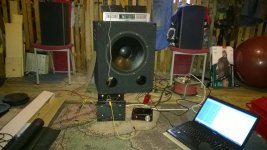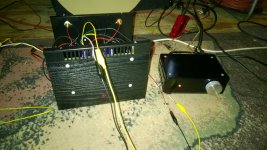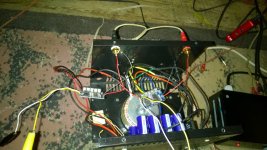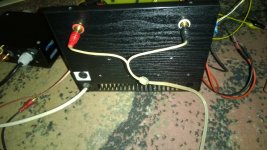An amplifier set to the conditional stability sweet spot (neither too nervous nor too placid) is a key factor.And why does the soundstage is getting "deeper" or why can someone hear "deeper" I think the recording?
This one has a dial for it: http://www.diyaudio.com/forums/atta...yle-no-lossy-emitter-resistors-tda7293dan.gif Also, there's fun clues.
Has someone here tested what kind of heatsink is needed for 50W continuous output power?
Do you think these will do the job?
AliExpress: Free Shipping 2sets DIY Cooler Aluminum Silver Heatsink Heat Sink kit For Banana Pi
Do you think these will do the job?
AliExpress: Free Shipping 2sets DIY Cooler Aluminum Silver Heatsink Heat Sink kit For Banana Pi
I got one module like the picture from first post.
Very bad. At 7 kHz start singing, audible noise.
From 10kHz attenuation is visible.
How big is the max level on entry ? I tested with 100mV and module become hot. On ouput I have 0.017V DC offset. Not tested yet with music only sine.
Very bad. At 7 kHz start singing, audible noise.
From 10kHz attenuation is visible.
How big is the max level on entry ? I tested with 100mV and module become hot. On ouput I have 0.017V DC offset. Not tested yet with music only sine.
Has someone here tested what kind of heatsink is needed for 50W continuous output power?
Do you think these will do the job?
AliExpress: Free Shipping 2sets DIY Cooler Aluminum Silver Heatsink Heat Sink kit For Banana Pi
I ordered a pair of Sanwu 8932 amps and a set of those exact radiators... Will try them when they arrive on a Markaudio CHR-70. Not quite 50W, but that's what I got 🙂
Has someone here tested what kind of heatsink is needed for 50W continuous output power?
Do you think these will do the job?
AliExpress: Free Shipping 2sets DIY Cooler Aluminum Silver Heatsink Heat Sink kit For Banana Pi
Tested out at 44W per chip sum total max Music Power (not continuous sine test), unless you get TDA8932BTW with its bigger heatsink facility.
The datasheet graph has near-identical figures with 8 ohm speakers (and the news is worse with 4 ohm speakers).
But, I don't think you can hear a 6W difference in decibels at the speaker. So, this post might be a nitpick.
Last edited:
My module came from China without the small black diode.
Please, tell me how to replace, type or schematic.
Please, tell me how to replace, type or schematic.
Hi everyone! I´m new here and have already received two 8932 modules.
I have a question regarding the power suppy. Does it have to be regulated? I would like to get by without a voltage regulator (two, actually) if I can.
I can only get either an 18V or 30V tranformer. When the 18 volts are rectified, I´ll have 25 volts idle voltage. If I use a 30 V trafo, I´ll have 42 volts (way too much).
I have a question regarding the power suppy. Does it have to be regulated? I would like to get by without a voltage regulator (two, actually) if I can.
I can only get either an 18V or 30V tranformer. When the 18 volts are rectified, I´ll have 25 volts idle voltage. If I use a 30 V trafo, I´ll have 42 volts (way too much).
Hi everyone! I´m new here and have already received two 8932 modules.
I have a question regarding the power suppy. Does it have to be regulated? I would like to get by without a voltage regulator (two, actually) if I can.
I can only get either an 18V or 30V tranformer. When the 18 volts are rectified, I´ll have 25 volts idle voltage. If I use a 30 V trafo, I´ll have 42 volts (way too much).
Just use an old laptop 19v SMPS.
Okay, thanks! I´´ll order the 18V trafo and the rest soon.
I´m really looking forward to hearing this little amp!
I´m really looking forward to hearing this little amp!
I use a SMPS 24V/10A to power 4 SANWU boards. Would it help to have each board fed through a capacitor to minimise problems? And what capacity would be enough? Thanks
Okay, thanks! I'll order the 18V trafo and the rest soon.
I´m really looking forward to hearing this little amp!
At worst, and what it usually does is sound just like a classic "silver face" 1970's amplifier. You can expect at least that much quality.
At best, which would take a bit more homework and take either efficient speakers or a creative multi-amp approach, then capacity for high fidelity does exist at a surprisingly low price point.
Personally, I think that both modes are rather entertaining, and the ever pleasant tone (which is rare), makes either job a bit easier. At this point, with so many successes and only a slight inconvenience (not expensive) for the cost, I think that this chip's fixed gain (stable in all conditions, albeit too high) might be a rather good idea. I think that the circuit may have an almost hidden lift-point for allowing customizations; and it makes sense to hide that because utilizing that almost hidden function would also shut off the everything-works-fine-all-the-time function. That's probably just good design, when you can't get into trouble unless you want to. 😀
Last edited:
i ordered three for testing, looks like it will drop right in to my valve hybrid.
Same ps as tpa3118 so no mods, the filter looks a little more accessible for cap upgrades too.
thanks
Same ps as tpa3118 so no mods, the filter looks a little more accessible for cap upgrades too.
thanks
@Daniel: My main system is powered by a QSC GX5 amp; my speakers are Cerwin Vega D15EE.
I´ll be using this little amp for casual listening with my Grundig Box 5600 ( that I picked up for free and refoamed 🙂 )
The fixed gain is no problem; I´ll be using my DIY pre to attenuate.
I´ll be using this little amp for casual listening with my Grundig Box 5600 ( that I picked up for free and refoamed 🙂 )
The fixed gain is no problem; I´ll be using my DIY pre to attenuate.
Several ways to go about it, but it comes down to this: Don't run tweeters in bridge mode.Please, say more about this homework. thanks.
If that wasn't clear, then read on; or, if it was clear, then skip the rest, because it just many different ways to say that same thing.
If you run at least the tweeters in SE mode, there's half the number of transistors in the way and also less gain. . . the combination of which amounts to much higher resolution. What you get is a very, very low cost for high end sound.
Some ways to consider include:
An inexpensive 2+1: That involves two efficient tweeters (they normally are) and one woofer, all powered by one chip. . . with the tweeters in SE mode and the woofer in bridge mode. Sum total power is 44W for TDA8932BT (although a 60+W model does exist, TDA8932BTW). Given a 6-1/2" woofer, a slightly spendy coil (crossover part), a couple resistors and caps, and two tweeters, the cost is embarrassingly low for high end audio. I've never seen a high end portable, but you could do it at market-possible cost. I'd probably buy it immediately. And, talk about it. Oh yeah. Make the cabinet big enough for a happy woofer, and throw in the bluetooth, and you're done.
Ordinary bi-amp: In this case you can use either SE or bridge for the woofers, and do be sure to use SE for the tweeters (and midranges).
Chances are high that your speaker already has an ordinary parallel crossover (the most popular) and that the tweeters are more efficient than the woofer (there aren't many exceptions), so that bi-amp could be, and probably is, far lower cost than you expect.
Helper tweeters: If you have a vintage system with now-dull tweeters or some full range speakers, either one of which could be in need of high end treble, just run some extra tweeters from TDA8932BT in SE mode (stereo with one chip) and enjoy more ear perking acoustic cues that we observe as good imaging.
When you wouldn't normally consider a Class D amplifier; and, there's no point to explaining that except that it may be unique. It is noteworthy to mention, efficiency is not as much as its peers that promise more and deliver unpleasantness instead of efficient output. However, if you're going to put your name to something, then I do have ideas on that; and, you're on the right page.
This post was cut for length; however, if there is more question, please ask more specifically so that we can enjoy doing it.
Edit: P.S.
Don't run tweeters from bridge mode.
One small schematic worth more then thousend words.
How to configure SE and BTL in the same time with one cip ?
Two passive crossover ? One one each SE channel ?
How to configure SE and BTL in the same time with one cip ?
Two passive crossover ? One one each SE channel ?
At the same time is easiest.One small schematic worth more then thousend words.
How to configure SE and BTL in the same time with one cip ?
Two passive crossover ? One one each SE channel ?
One cap (range 4u7~10u), with one of its pins soldered to Power ground.
The other pin (of that new cap) is the negative for your tweeter.
In this case the tweeter needs to be more efficient than the woofer. But, they usually are.
Where your woofer is connected is full power bridge output. That local has TWO outputs. Use (one of) whichever is most pleasant for your tweeter +.
P.S.
If your tweeter diaphragm is bigger than 1.9 inches, then it is possible we would be in need of a schematic (wee little adapter circuit possibly necessary), so please make another post if that is the case. I haven't tried this with any tweeters larger than 5 inches. A bigger dc-block cap will delay startup slightly.
Last edited:
Does anyone have an idea how to mount these tiny boards inside a metal case?
The holes are only 3mm; I don´t know if I can get 2.5mm screws here in town.
Hot glue would be easiest, but I can imagine that when the board gets hot, that the glue will get soft.
Silicone would be another possibility, but I am worried about corrosion. Most silicon has acetic acid in it.
The holes are only 3mm; I don´t know if I can get 2.5mm screws here in town.
Hot glue would be easiest, but I can imagine that when the board gets hot, that the glue will get soft.
Silicone would be another possibility, but I am worried about corrosion. Most silicon has acetic acid in it.
So, I was able to test the amp this afternoon.
I still haven´t mounted the boards; they were just hanging around for the test. The speaker connectors that I ordered are not insulated, so I´ll have to mount them on wood or plastic.
It seems to sound okay. I would love to do a quick comparison with my QSC amp, but it takes a few minutes to switch the cables; so it´s hard to do a direct comparison.
I was only listening at 72-75 dbA at around 2 meters from the speakers and the chips were too hot to touch for more than a few seconds. Is that normal?
I think the amp was putting out less than one watt at that volume.
I still haven´t mounted the boards; they were just hanging around for the test. The speaker connectors that I ordered are not insulated, so I´ll have to mount them on wood or plastic.
It seems to sound okay. I would love to do a quick comparison with my QSC amp, but it takes a few minutes to switch the cables; so it´s hard to do a direct comparison.
I was only listening at 72-75 dbA at around 2 meters from the speakers and the chips were too hot to touch for more than a few seconds. Is that normal?
I think the amp was putting out less than one watt at that volume.
Attachments
- Home
- Amplifiers
- Class D
- Fasten seat belts. TDA8932 pessimistic review.



